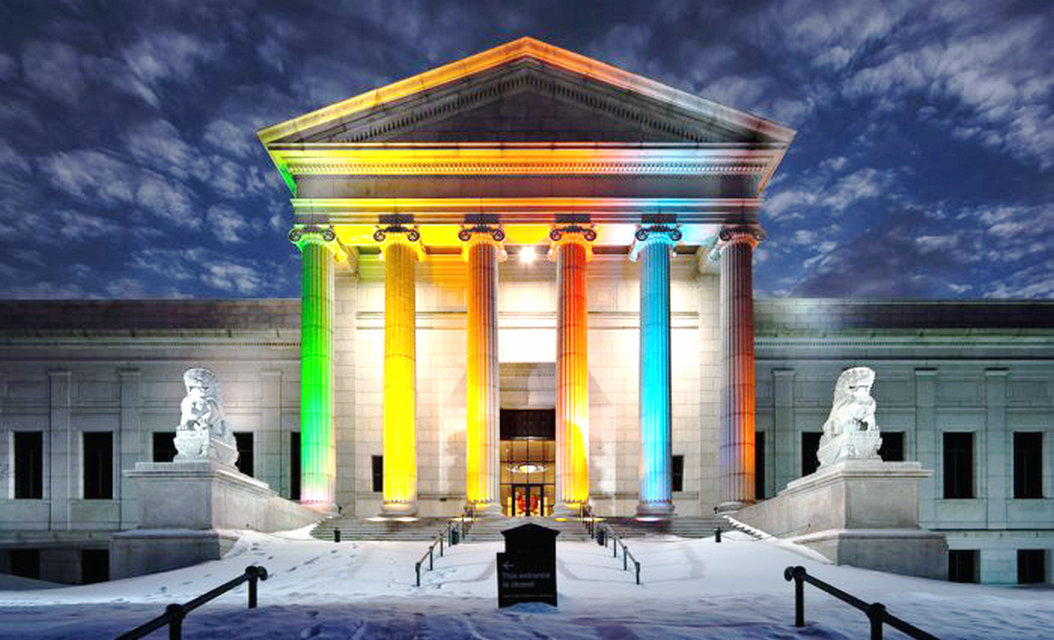The Minneapolis Institute of Art (Mia), formerly known as the Minneapolis Institute of Arts, home to one of the finest encyclopedic art collections in United States, houses more than 80,000 works of art representing 5,000 years of world history. Highlights of the permanent collection include European masterworks by Rembrandt, Poussin, and van Gogh; modern and contemporary painting and sculpture by Picasso, Matisse, Mondrian, Stella, and Close; as well as internationally significant collections of prints and drawings, decorative arts, Modernist design, photographs, textiles, and Asian, African, and Native American art.
The Minneapolis Institute of Art is a fine art museum located in the Whittier neighborhood of Minneapolis, Minnesota, on a campus that covers nearly 8 acres (32,000 m²), formerly Morrison Park. As a major, government-funded public museum, the Institute does not charge an entrance fee, except for special exhibitions, and allows photography of its permanent collection for personal or scholarly use only. The museum receives support from the Park Board Museum Fund, levied by the Hennepin County commissioners. Additional funding is provided by corporate sponsors and museum members. It is one of the largest art museums in the United States.
The museum features an encyclopedic collection of approximately 80,000 objects spanning 5,000 years of world history. Its collection includes paintings, photographs, prints & drawings, textiles, architecture, and decorative arts. There are collections of African art, art from Oceania and the Americas, and an especially strong collection of Asian art, called “one of the finest and most comprehensive Asian art collections in the country”. The Asian collection includes Chinese architecture, jades, bronzes, and ceramics.
In order to encourage private collecting and assist in the acquisition of important works of art, the museum has created “affinity groups” aligned with the seven curatorial areas of the museum. The groups schedule lectures, symposia, and travel for members.
The museum features a regular series of exhibitions that bring in traveling collections from other museums for display. Local business partners fund many of these exhibitions, and some feature the artists leading public tours through the exhibition.
The museum houses the Minnesota Artists Exhibition Program, an artist-controlled program devoted to the exhibition of works by artists who live in Minnesota.
The institute has a number of exhibits outside the building. A pair of Chinese lions sit on either side of the 24th Street entrance. They were a gift from Ella Pillsbury Crosby in 1998. Because a museum curator determined that it would be too difficult to export 18th-century statues, new ones were carved in China in the 18th century style.
The bronze statue The Fighter of the Spirit, by Ernst Barlach stands near the 24th Street entrance. The statue shows a winged man holding a sword vertically, tip up, and standing on the back of a snarling beast. The statue was commissioned by the University of Kiel and was originally placed in front of its church (Holy Spirit Church). The statue did not fit with the ideals of the ruling National Socialist party; it was vandalized and condemned as degenerate art. As a result, the statue was removed and cut into four pieces, in preparation for melting down. However, the pieces were hidden on a farm and didn’t resurface until 1946. The statue was repaired and placed in front of the Church of St. Nicholas (the Holy Spirit Church having been destroyed during the war). Two copies of the statue were made at this time; the MIA acquired one copy in 1959; the other is in front of the Gethsemane Church in Berlin.
The Chinese Garden, which can be seen from inside the café, contains Taihu stones. These stones are said to represent the mountains of the Buddhist and Taoist immortals. The garden was a gift of Ruth and Bruce Dayton.
Target Park, which sits behind the museum, contains several contemporary statues, including an untitled work in bronze (c. 1968) by Pietro Consagra, Samba in African granite (1993) by Richard Erdman, and L’arbre de vie in stainless steel and pigment (20th century), designed by Jean Willy Mestach and manufactured by Michael Chowen. There is also a granite and steel pavilion entitled Labyrinth (1993 ) by John Willenbecher. There are wide lines cut into the steel roof of the pavilion so that when the viewer stands inside, the labyrinth can be viewed by looking up.
To celebrate its 100th anniversary, the institute purchased a sculpture by the late Polish artist Igor Mitoraj (1944–2014). Eros Bendato Screpolato, 1999, is one of a series of bronze “bandaged heads” produced by Mitoraj. Similar Mitoraj sculptures can be found at other public sites, including Market Square in Krakow, Poland, and Citygarden in downtown St. Louis, Missouri.
